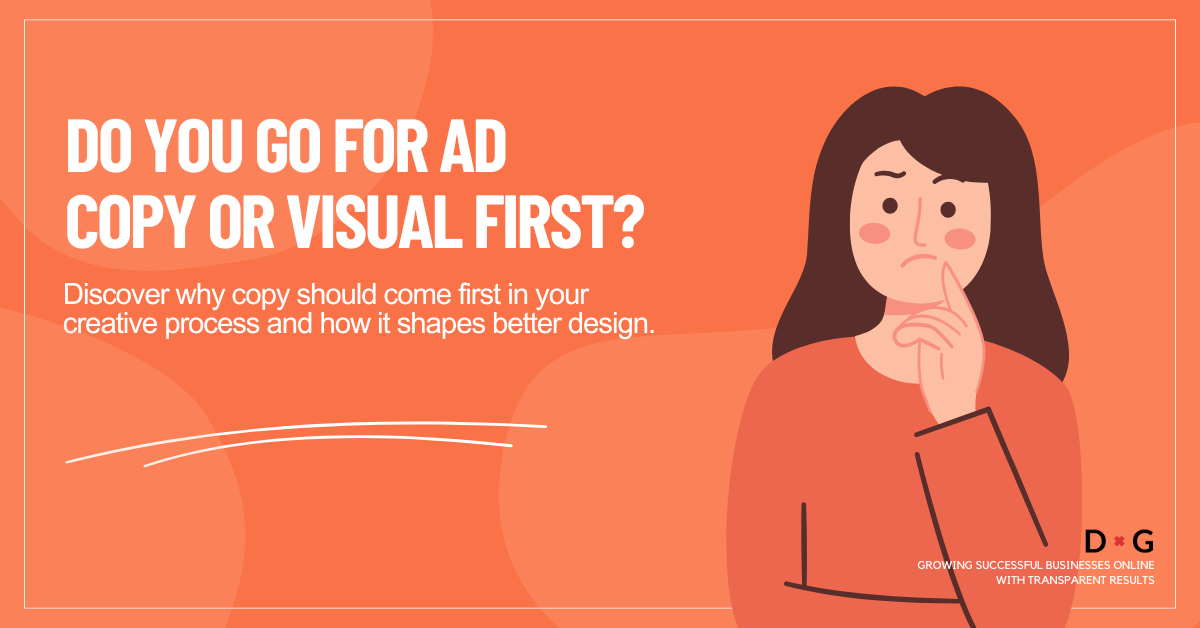
Do you go for ad copy or visual first? It’s a common question that comes up whenever a new paid ad campaign is about to begin. Both elements play a critical role; one grabs attention, the other drives action.
But figuring out where to begin isn’t always straightforward, and the way you start your creative process can shape the outcome of your entire campaign.
Let’s see how the order of copy and visuals affects your strategy and why it matters in building ads that perform.
Why This Question Matters in Paid Advertising
The way you start a creative project affects how well it performs.
In paid ads, copy and visuals must work together, but starting with the wrong element can lead to weak messaging, cluttered design, or mixed signals, and in advertising, clarity wins.
Why You Should Start with the Ad Copy
Because a message sets the direction.
Before you open your tools to create static images, videos, carousel, and or stock photos, ask:
What’s the one thing we want to say?
Once you’re clear on that, everything else, colours, images, and layout, becomes easier.
Copy is about defining the core message. That message gives your visuals meaning and your offer impact.
Words Define the Core Idea
Think of your ad copy as the blueprint. Without it, you’re guessing.
- Copy sets the tone: playful, bold, professional, or emotional.
- It defines the structure: headline, body text, CTA.
- It speaks directly to your audience’s needs.
So, if you’re stuck with your creative, don’t chase a better design; start with the messaging you want to mention.
How Visuals Support, Not Lead
Design is a vehicle for emotion and action.
When you lead with copy, your design doesn’t compete; it carries the message.
Strong visuals:
- Draw attention
- Support the tone set by the copy
- Help explain the message quickly
But without the right words, even the best visuals fail to communicate.
What Logos and Ad Creative Have in Common?
Think about how a logo is made.
Before a designer begins sketching, they ask questions to a client:
- What’s your story?
- What are your values?
- What’s your mission?
These answers shape the design and help create a logo that’s more than just a pretty shape. It carries meaning because it’s built on a clear story.
Paid ads work the same way. With the story, the design becomes powerful. Without it, it’s just decoration.
When to start with Visuals and when does it make sense?
Are there times when you can start with a visual? Yes, but they’re the exception.
You can choose to begin with an image or video if:
- You’re running video ads purely to tell a story, with minimal text
- You’re creating a carousel where the message is built into each frame
But even then, the copy should quickly follow to anchor the message.
Visuals attract. Words convert.
Best practices for combining copy and visuals to get the most from your ads:
Write your message first:
What’s the core idea?
Match visuals to the tone and story:
Fun, bold, calming?
Keep it simple:
One clear message per ad
Test combinations:
See what works better, long copy vs short, photo vs video.
When your words and images work together, the result is more than a pretty ad, it’s a high-performing campaign.
Conclusion
So, do you go for ad copy or visual first?
In most cases, advertising always starts with an ad copy.
The words define what you’re saying, who you’re saying it to, and why it matters. The design then brings that story to life.
When you begin with the message, your visuals become more than decoration; they become tools for emotion, clarity, and action.
So if you’re ever stuck with creativity, remember this: start with the copy, the words will show you where to go.
